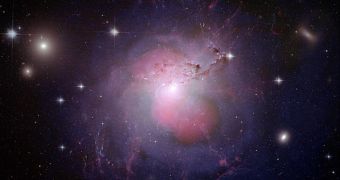According to a new scientific study, it would appear that black holes are perfectly capable of destroying entire galaxies. The structures can paralyze galactic growth via massive energy discharges, basically canceling any chance young blue stars have of developing, and forcing all other stars to a slow death. Once the last stars are extinguished, the galaxy by all accounts and purposes disappears. The way the black hole accomplishes this is by emitting such vast amounts of X-ray radiation that it blows away all cosmic dust and gas, clouds of which generally drive stellar formation, Space reports.
Data from the Hubble Space Telescope and the Chandra X-ray Observatory have revealed that the X-ray signature of supermassive black holes far outshine that of any other radiation source in the Universe significantly. Additionally, it was also found that, at one point, most galaxies that now contain such huge black holes at their cores were dwarfed in brightness by these structures. The black holes create such impressive outpourings of energy through their accretion disks, which are areas in which matter the dark behemoth attracts swirls for a while, before finally falling through the event horizon.
As matter in the disks clumps together under the massive force at work there, it heats up and then naturally emits radiations. In some instances, the amount of X-rays is so large that all surrounding gas and dust in the galaxy is displaced. Given that these are the main fuels for new star formation, no blue fireballs appear to replace aging ones. The objects that remain eventually reach the end of their burning cycle and disappear, without having ever been replaced.
“We are left with a startling picture of the formation history of massive galaxies, where dramatic violence in the form of the torrent of radiation from matter falling into black holes leads to the death of galaxies they inhabit. Black holes form inside their host galaxies and grow in proportion to them, forming an accretion disc which will eventually destroy the host. In this sense they can be described as viral in nature,” says astrophysics researcher Asa Bluck, who is based at the University of Nottingham, in England. The expert adds that, in the case of our galaxy, the black hole at the core is still fairly “calm.” Still, there is no guarantee that it will remain this way in the future as well.

 14 DAY TRIAL //
14 DAY TRIAL //